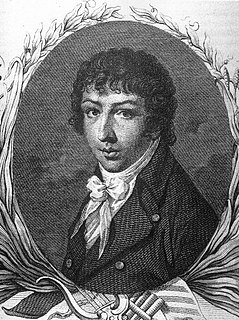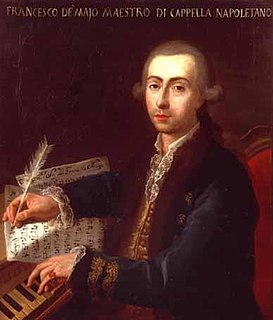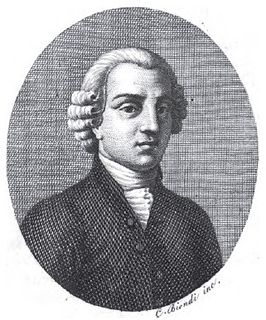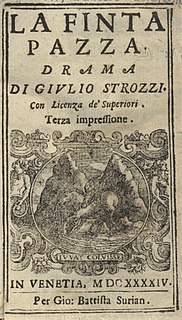
Pietro Antonio Domenico Trapassi, better known by his pseudonym of Pietro Metastasio, was an Italian poet and librettist, considered the most important writer of opera seria libretti.

Opera seria is an Italian musical term which refers to the noble and "serious" style of Italian opera that predominated in Europe from the 1710s to about 1770. The term itself was rarely used at the time and only attained common usage once opera seria was becoming unfashionable and beginning to be viewed as something of a historical genre. The popular rival to opera seria was opera buffa, the 'comic' opera that took its cue from the improvisatory commedia dell'arte.
The year 1722 in music involved some significant events.
The year 1721 in music involved some significant events.

Giuseppe Gazzaniga was a member of the Neapolitan school of opera composers. He composed fifty-one operas and is considered to be one of the last Italian opera buffa composers.

Gli equivoci, is an Italian opera buffa by Stephen Storace to a libretto by Lorenzo Da Ponte, based on Shakespeare's The Comedy of Errors.
Domenico Fischietti (1725–1810) was an Italian composer.

Giuseppe Maria Orlandini was an Italian baroque composer particularly known for his more than 40 operas and intermezzos. Highly regarded by music historians of his day like Francesco Saverio Quadrio, Jean-Benjamin de La Borde and Charles Burney, Orlandini, along with Vivaldi, is considered one of the major creators of the new style of opera that dominated the second decade of the 18th century.

Giacomo Domenico Mario Antonio Pasquale Giuseppe Tritto was an Italian composer, known primarily for his fifty-four operas. He was born in Altamura, and studied in Naples; among his teachers were Nicola Fago, Girolamo Abos, and Pasquale Cafaro. Amongst his pupils were the young Vincenzo Bellini around 1821, plus Ferdinando Orlandi. He died in Naples.

Gian Francesco de Majo was an Italian composer. He is best known for his more than 20 operas. He also composed a considerable amount of sacred works, including oratorios, cantatas, and masses.

Nicola Conforto was an Italian composer.
António Leal Moreira was a Portuguese Classical composer and organist. He composed a large number of operas, most of which were premiered in Lisbon; much of the rest of his output is sacred, though he composed a handful of symphonies as well. One of his works, Sinfonia para a Real Basílica de Mafra, is an organ symphony composed specifically for the 6 organs of Mafra National Palace's Basilica.
The Real Compañía Ópera de Cámara de Barcelona orchestra (RCOC) is a Spanish early music ensemble based in Barcelona. It was founded by its conductor Juan Bautista Otero. The orchestra has been instrumental in reviving several long unperformed Baroque operas.

Sebastiano Biancardi, known by the pseudonym Domenico Lalli, was an Italian poet and librettist. Amongst the many libretti he produced, largely for the opera houses of Venice, were those for Vivaldi's Ottone in villa and Alessandro Scarlatti's Tigrane. A member of the Accademia degli Arcadi, he also wrote under his arcadian name "Ortanio". Lalli was born and raised in Naples as the adopted son of Fulvio Caracciolo but fled the city after being implicated in a bank fraud. After two years wandering about Italy in the company of Emanuele d'Astorga, he settled in Venice in 1710 and worked as the "house poet" of the Grimani family's theatres for the rest of his career. In addition to his stage works, Lalli published several volumes of poetry and a collection of biographies of the kings of Naples. He died in Venice at the age of 62.

Cora is an opera in four acts by the French composer Étienne Méhul. The libretto, by Valadier, is based on the novel Les Incas by Jean-François Marmontel. It was the first opera Méhul wrote but the second to be performed, receiving its premiere at the Académie Royale de Musique on 15 February 1791. Cora was not a success and there were only four more performances.

La finta pazza is an opera composed by Francesco Sacrati to a libretto by Giulio Strozzi. Its premiere in Venice during the Carnival season of 1641 inaugurated the Teatro Novissimo. It became one of the most popular operas of the seventeenth century.

Arianna in Nasso is a 1733 opera by Nicola Porpora to a libretto by Paolo Rolli, chief conductor of the Opera of the Nobility. The choice of the subject of Ariadne was a challenge to Handel, whose Arianna in Creta was completed by 5 October 1733. Handel's Arianna in Creta was based on Pietro Pariati's much-set Arianna e Teseo, in the later of two versions by Leonardo Leo (1729). This was a libretto which Porpora himself had also used for his own Arianna e Teseo (1721). Handel's choice of libretto obliged Porpora to turn to Rolli's libretto which was modeled not on Pariati but on Stampa's libretto to Giovanni Porta's dramma pastorale, Arianna.
Gli dei a Tebe is an opera in three acts by Ermanno Wolf-Ferrari on a libretto by Mario Ghisalberti, performed for the first time at the Opernhaus in Hannover on 4 June 1943. The first performance used the translation of the libretto in German by Franz Rau. Ghisalberti had in turn derived the libretto from a work by the publisher Ludwig Strecker, who wrote librettos under the pseudonym Ludwig Andersen.

Temistocle is an opera in three acts composed by Nicola Porpora to an Italian libretto by Apostolo Zeno. It was first performed at the Hoftheater in Vienna on 1 October 1718. It is possibly the same opera that was performed on 30 May 1756 at the Teatre de la Santa Creu, Barcelona.













